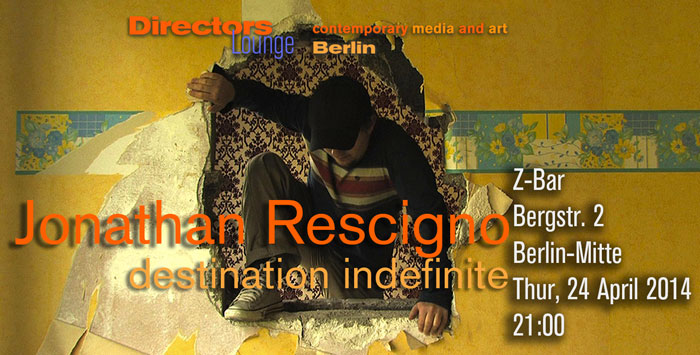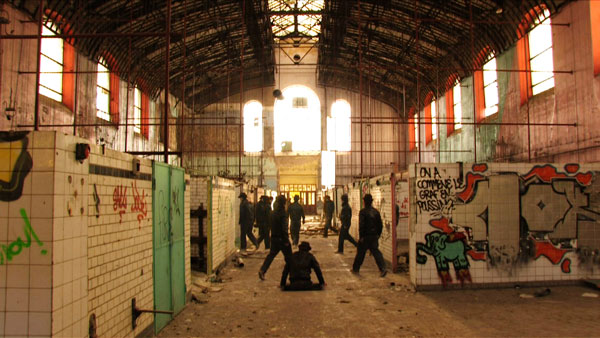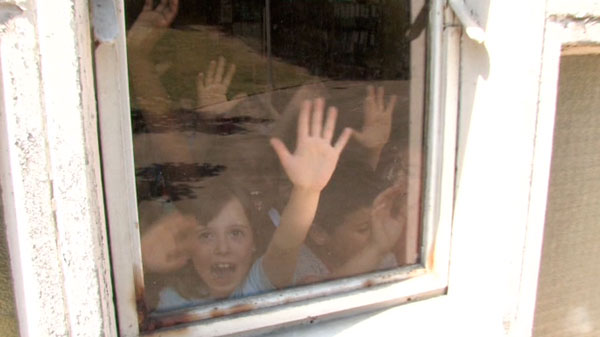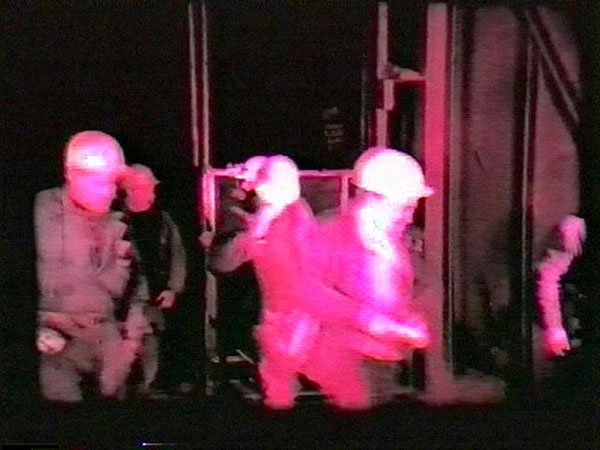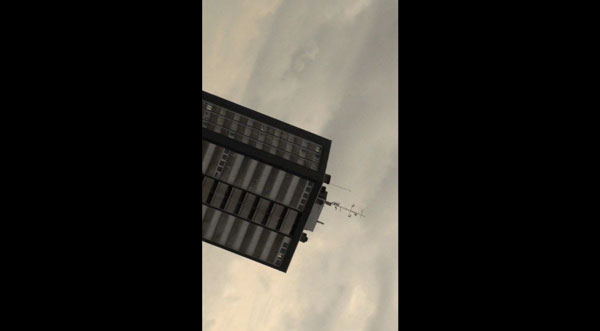directors lounge monthly screenings
Directors Lounge Screening:
jonathan rescigno
destination indefinite
Donnerstag, 24. April 2014
21:00
Z-Bar
Bergstraße 2
10115 Berlin-Mitte
Jonathan Rescigno verfolgt einen dokumentarischen Ansatz, den er aber zugleich verwandelt und fiktionalisiert. Ihn interessieren Geschichten des Alltags seiner Umgebung, die aber zugleich von allgemeiner Bedeutung sein können, und er verbindet so Mittel des narrativen, sozial engagierten Filmes mit Elementen der frühen Avantgarde und der Nouvelle Vague. Diese Suche nach einer eigenen Bildsprache brachte ihn auch dazu, von der Filmschule an die Kunsthochschule Metz zu wechseln und schließlich mit "Film and Creative Documentaries Direction" in Straßburg abzuschließen. Seine Bilder verbindet eine subtile Recherche von Orten und Menschen mit einem essayistischen Bildansatz in der Montage, der eher einer offenen atmosphärischen Beschreibung folgt und dem Betrachter den Spielraum zur eigenen Interpretation läßt, statt in dokumentarischer Manier Fakten zu konstruieren.
In seinen Filmen sucht er immer wieder die Auseinandersetzung mit Themen aus seiner Heimat Lothringen, dem lange prosperierenden französischen Kohlerevier, mit dem Ruhrgebiet verbunden über die Montan-Union. Die Region durchlebt heute eine noch schwierige Phase der Deindustrialisierung als der sogenannte Kohlenpott. Mehrere Filme gehen direkt diesem Thema nach: "Glory Hole" geht als Foundfootage-Film in seiner Remontage den fast erotischen Beziehungen der früheren Bergbauarbeitern mit ihrer Grube (frz. veine, die Vene) nach. In "Core'ngrato" (Nach dem Lied "böses Herz") belebt er mit künstlerischen Mitteln der Selbstinszenierung den Ort, an dem die Grubenarbeiter früher vor der Arbeit ihre Kleider ablegten und in Körben hängten . Und in "Destination Lune" besucht er das ehemalige Neubaugebiet in dem er selbst aufgewachsen ist, kurz bevor und nachdem es dem Abriss preisgegeben wurde.
"Maria" schneidet noch ein weiteres Thema an. Der Film ist aus der Arbeit mit einer Schulklasse entstanden, und aus der dokumentarischen Recherche über dieselbe Klasse mit Maria, ein angolanisches Mädchen. Maria und ihrer Mutter warteten zu der Zeit der Aufnahmen auf die Anerkennung ihres Asylantrages. Die Schulklasse andererseits inszeniert als Trickfilm das Märchen einer Fee, die den Weg in ihr eigenes Land sucht. Nach Abschluss der Dreharbeiten realisiert Rescigno, dass es sich bei der Fee und bei Maria um die gleiche Story handelt und er schneidet den Film neu, indem er die Geschichten parallel zusammen führt. Maria's Story findet auf der Textebene als Titeleinblendung statt, während die Geschichte der Fee als audiovisuelle Narration erzählt wird. Maria allerdings, so erfahren wir, muss am Ende des Jahres die Schule verlassen, ihr Antrag wurde abgelehnt und für den Filmemacher ist es schließlich nicht mehr möglich, sie wieder zu finden. So schlagen am Ende die parallelen Geschichte in gegensätzliche Endings um, das Happy-End des Märchens gegen das offene ungewisse erzählerische Ende über Maria.
"Sea View" beschäftigt sich auf andere Weise mit der Suche nach Identität. Mit Bezug auf seiner Großmutter, die einst aus Italien nach Lothringen kam, fragt Jonathan nach der Identität von Franzosen, deren Großeltern eingewandert sind. Diese sind als Franzosen geboren, deren bisherige Normalität wird aber sowohl von der konservativen bis rechtsnationalen Politik in Frage gestellt, als auch von Jüngeren, die sich nicht mehr selbstverständlich als Franzosen verstehen. Zugleich zeigt Rescigno Bilder von Wohnhochhäusern, deren Abriss die Identität verändert, von in 60er und 70er Jahren entstandene Städten und Vorstädten. Sea View ist aber zugleich der Film, in dem Rescigno am weitesten mit der Dekonstruktion des Dokumentarischen geht. Die Aufnahmen der Hochhäuser werden im Film dekonstruiert, noch bevor die Phasen ihre Demolierung im Film sichtbar werden. Zugleich wird im gesprochenen und geschriebenen Wort eine im besten Sinne komplementäre Erzählung eingeführt: die Erzählung der Großmutter aus dem "Off". Es entsteht eine Gegenüberstellung von Wort und Bild, die sich erst dann überlagern, als Bilder und Töne von Jugendliche gezeigt werden, die sich unterhalten während sie auf Abbruchsarbeiten blicken, und deren "On" die beiden Ebenen von Text und Bild konvergieren lassen.
Obwohl es bei Rescigno meist eine Kontinuität der Erzählzeit gibt, die sich aus kontingenten subtilen Beobachtungen zusammensetzt, und die einen ruhigen Erzählfluss erzeugen, ist es doch so, dass die eigentliche Narration, sich aus der Montage unterschiedlicher Ebenen erst ergibt. Für die große Erzählung entsteht so eine recht ungewöhnlicher Erzählperspektive.
Programm:
Glory Hole 10:03 min 2008
Destination Lune 20 min2010
Maria 13:00min 2008
Sea view / Avec vue sur la mer 21:40 min 2012
Coren'grato 6:20 min 2012
Artist's Links:
http://www.jorescigno.com/
Press Links:
Z-Bar - http://www.z-bar.de/
Directors Lounge
 Back Back
|
